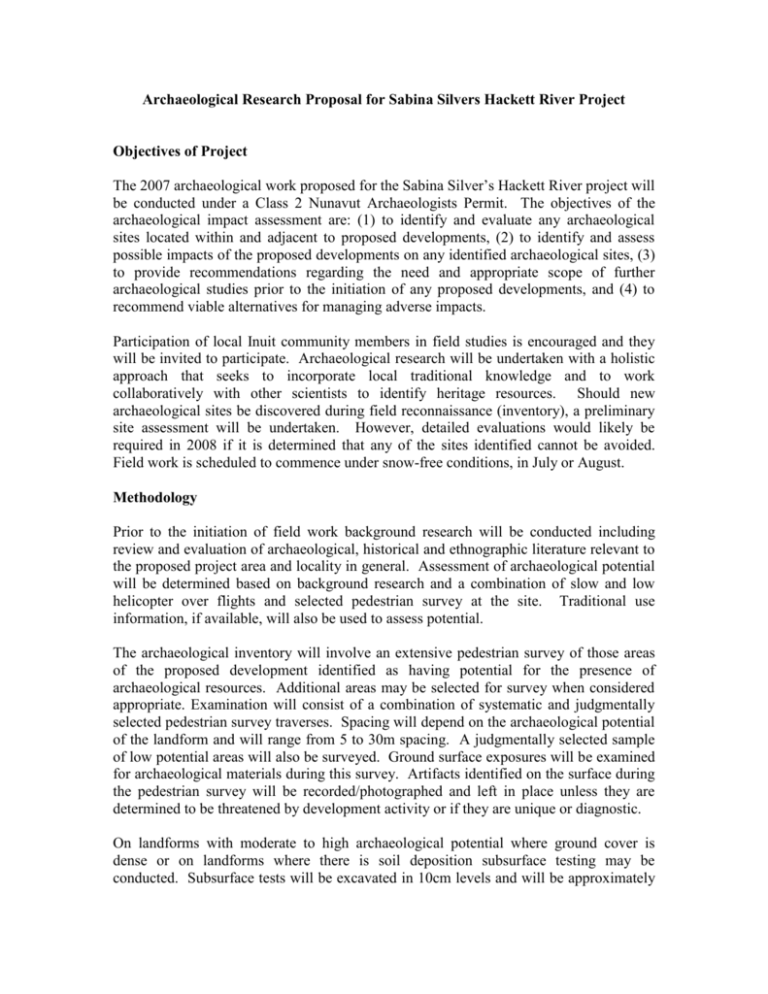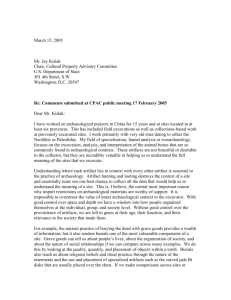070405-07YN030-Archaeological Summary
advertisement

Archaeological Research Proposal for Sabina Silvers Hackett River Project Objectives of Project The 2007 archaeological work proposed for the Sabina Silver’s Hackett River project will be conducted under a Class 2 Nunavut Archaeologists Permit. The objectives of the archaeological impact assessment are: (1) to identify and evaluate any archaeological sites located within and adjacent to proposed developments, (2) to identify and assess possible impacts of the proposed developments on any identified archaeological sites, (3) to provide recommendations regarding the need and appropriate scope of further archaeological studies prior to the initiation of any proposed developments, and (4) to recommend viable alternatives for managing adverse impacts. Participation of local Inuit community members in field studies is encouraged and they will be invited to participate. Archaeological research will be undertaken with a holistic approach that seeks to incorporate local traditional knowledge and to work collaboratively with other scientists to identify heritage resources. Should new archaeological sites be discovered during field reconnaissance (inventory), a preliminary site assessment will be undertaken. However, detailed evaluations would likely be required in 2008 if it is determined that any of the sites identified cannot be avoided. Field work is scheduled to commence under snow-free conditions, in July or August. Methodology Prior to the initiation of field work background research will be conducted including review and evaluation of archaeological, historical and ethnographic literature relevant to the proposed project area and locality in general. Assessment of archaeological potential will be determined based on background research and a combination of slow and low helicopter over flights and selected pedestrian survey at the site. Traditional use information, if available, will also be used to assess potential. The archaeological inventory will involve an extensive pedestrian survey of those areas of the proposed development identified as having potential for the presence of archaeological resources. Additional areas may be selected for survey when considered appropriate. Examination will consist of a combination of systematic and judgmentally selected pedestrian survey traverses. Spacing will depend on the archaeological potential of the landform and will range from 5 to 30m spacing. A judgmentally selected sample of low potential areas will also be surveyed. Ground surface exposures will be examined for archaeological materials during this survey. Artifacts identified on the surface during the pedestrian survey will be recorded/photographed and left in place unless they are determined to be threatened by development activity or if they are unique or diagnostic. On landforms with moderate to high archaeological potential where ground cover is dense or on landforms where there is soil deposition subsurface testing may be conducted. Subsurface tests will be excavated in 10cm levels and will be approximately 40 cm by 40 cm. Materials recovered from tests will be screened through 6mm mesh screen or hand and/or trowel sorted. The location of subsurface tests will be judgmentally determined. Any artifacts found during subsurface testing will be collected, as their context has been disturbed. When necessary, more detailed site assessments may be conducted. These assessments will involve more intensive surface examination and subsurface testing. Subsurface tests will be conducted in a systematic way to determine site boundaries and archaeological significance. One to five evaluative tests may be excavated in order to obtain additional information regarding site content, integrity, and stratigraphy. Evaluative testing will involve the controlled excavation of 50 x 50 cm or 100 x 100 cm test units, dug in 10 cm levels to underlying non-cultural deposits (5cm levels may be used if extensive cultural deposits are encountered). The evaluative units will be positioned in order to provide information from different parts of the site, keeping site disturbance from testing to a minimum. Sediments from the tests will be screened through 6 mm mesh. Artifacts, identifiable faunal remains, and datable materials (such as charcoal) will be collected for further analysis. Profile drawings of sediment stratigraphy and features exposed in walls will be prepared. Detailed notes will be taken and the site area will be mapped (including location of tests, features, and significant artifacts). If any sites are found to be immediately threaten by development and avoidance until 2008 is not possible mitigation measures may be taken that will include subsurface excavation and intensive surface collection. Site size and significance will determine the number of subsurface tests. The methodology described in the previous paragraph will be used. Professional judgment will be used for site assessments and will relate to the potential scientific value and potential to contribute to the regional cultural history. The assessment of impact potential will be based on the site’s type and potential significance. Avoidance is always the preferred option. Where avoidance is not possible the condition and significance of the site will be used to determine appropriate mitigation recommendations. All archaeological sites identified will be recorded in field notes, photographed and GPS coordinates will be obtained. The location of all sites will be plotted on 1:50,000 field maps. Site forms for all archaeological sites recorded during this study will be submitted to the Chief Archaeologist of Nunavut and the Canadian Museum of Civilization. As the focus of this study is to identify archaeological sites in the proposed development zone it is not anticipated that a large number or artifacts will be collected. All artifacts will be catalogued, descriptively classified, measured (when complete or near complete) and compared to existing regional typologies. A minimum of 10% of faunal remains recovered from each feature will be reported on. Lithic artifacts will be analyzed by the permit holder, faunal material and organic artifacts will be analyzed and if conservation is required will be submitted to Cross Art Conservation. As per the “Guidelines for Applicants and Holders of Nunavut Territory Archaeology and Paleontology Permits” the following will be done: A non-technical summary report will be submitted by September 30. 2007. A conservation report will be prepared and submitted by October 31, 2007. A technical report will be submitted on or before March 31, 2008 Artifacts, faunal remains, samples of soil, charcoal, shell, pollen etc., site forms, photo documentation, catalogues, field notes, and report will be sent to the repository (indicated on permit) by March 31, 2008







